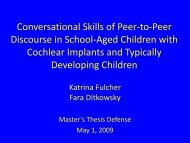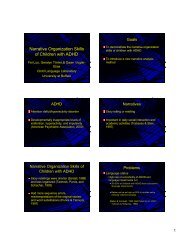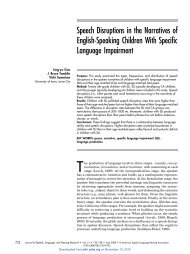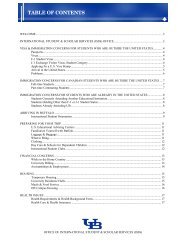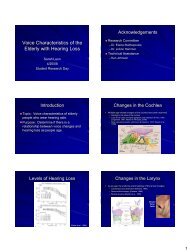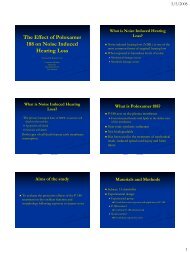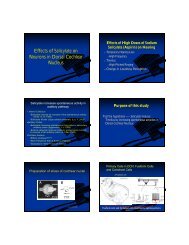Chronic Aphasia: Life After Treatment
Chronic Aphasia: Life After Treatment
Chronic Aphasia: Life After Treatment
Create successful ePaper yourself
Turn your PDF publications into a flip-book with our unique Google optimized e-Paper software.
Unanswered<br />
Questions/<br />
Future Research<br />
3. What types of outcome measures<br />
best document non-traditional<br />
improvements in both PWAs and<br />
caregivers: including quality of life,<br />
stress, burden, depression, and other<br />
psychosocial outcomes?<br />
References<br />
American Stroke Association (2005). Heart disease and stroke statistics<br />
2005 update. Retrieved March 24, 2008, from<br />
www.americanheart.org.<br />
Barthel, G., Meinzer, M., Djundja, D., & Rockstroh, B. (2008).<br />
Intensive language therapy in chronic aphasia: Which aspects<br />
contribute most? Aphasiology, 22(4): 408-421.<br />
Centers for Disease Control (1999, August), Achievements in public<br />
health, 1900-1999. Morbididty and Morality Weekly Report, 48<br />
(30).<br />
Chapey, R. (Ed.) (2008). Language Intervention in Adult <strong>Aphasia</strong>. 5 th<br />
Edition. Baltimore: Williams and Wilkins.<br />
Cherney, L., & Robey, R. (2008). <strong>Aphasia</strong> treatment: Recovery,<br />
prognosis, and clinical effectiveness. In R. Chapey (Ed.),<br />
Language Intervention in Adult <strong>Aphasia</strong> (5 th ed.), (pp. 148-172).<br />
Baltimore: Williams and Wilkins.<br />
Clark, N., & Rakowski, W. (1983). Family caregivers of older<br />
adults: Improving helping skills. The Gerentologist, 23(6), 637-<br />
642.<br />
1. Further research needs to focus on<br />
well-defined therapy methods for<br />
specific types of aphasics both at the<br />
acute and chronic stages using higher<br />
levels of evidence.<br />
2. How can we help acute and chronic<br />
PWAs and caregivers cope with<br />
communication changes despite<br />
degree of improvement?<br />
4. What therapy techniques facilitate<br />
communication in a variety of living<br />
settings (home, skilled living, nursing<br />
home)?<br />
5. What is the cost effectiveness of<br />
various therapy approaches for<br />
PWAs and caregivers?<br />
References<br />
Darley, F. L. (1972). The efficacy of language rehabilitation in<br />
aphasia. Journal of Speech and Hearing Disorders, 37, 3-21.<br />
Fox, L., Poulsen, S., Bawden, K., & Packard, D. (2004). Critical<br />
elements and outcomes of a residential family-based<br />
intervention for aphasia caregivers. Apahsiology, 18(12), 1177-<br />
1199.<br />
Fink, R., & Schwartz, M. (2000). MossRehab <strong>Aphasia</strong> Center: A<br />
collaborative model for long term rehabilitation. Topics in<br />
Stroke Rehabilitation, 7(2), 32-43.<br />
Frattali, C. (1998). Measuring Outcomes in Speech-Language Pathology.<br />
New York: Thieme.<br />
Golper, L. & Brown, K. (2007). Applying evidence to clinical<br />
practice. In R. Lubinski, L. Golper, & C. Frattali (Ed.),<br />
Professional Issues in Speech-Language Pathology and Audiology (3 rd<br />
ed.), (pp. 560-576). NY: Thomson Delmar Learning.<br />
5/5/2008<br />
5



